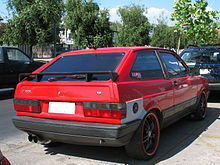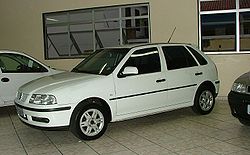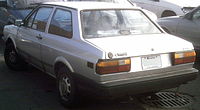VW Gol
| Volkswagen Gol | |
|---|---|
| Production period: | since 1981 |
| Class : | Small car |
| Body versions : | Sedan , hatchback , station wagon , pick-up |
The VW Gol is a small car built by Volkswagen in Brazil for the Latin American market . Its name is derived from the Brazilian-Portuguese or Spanish word Gol (from English Goal = soccer goal ).
From 1987 to 2013 the VW Gol was the best-selling vehicle in Brazil without interruption. From 1998 to 2009 and 2011 also in Argentina. On August 24, 2012, production passed the seven million mark. Production takes place at the Brazilian locations in Anchieta and Taubaté .
General
The first VW Gol was developed from 1979 and offered in Brazil from 1981. In Brazil and other South American countries, the Gol replaced the VW Brasília . The body was designed by Phillip Schmidt, who was already involved in the VW Polo . He drew a body with stylistic elements from the Polo and Golf . Conceptually, the Gol is closely related to the Volkswagen prototype EA 276 from 1969, a failed design for a successor to the Beetle . Like the EA 276, it has an air-cooled engine and front-wheel drive . The engine is therefore installed lengthways, as in the first Passat , not across as in the Polo and Golf . Only the third generation got a new platform with a transverse engine.
Model history
1st generation (type BX)
| Type BX | |
|---|---|
| Production period: | 1981-1996 |
| Engines: |
Gasoline engines : 1.0–2.0 liters (40–92 kW) |
| Length: | 3810-4080 mm |
| Width: | 1650 mm |
| Height: | 1410 mm |
| Wheelbase : | 2470 mm |
| Empty weight : | 895-1120 kg |
The first generation of the VW Gol was manufactured from 1981 to 1996. VW used technical components from VW and Audi, parts of the floor pan of the Audi 80 B1 combined with the air-cooled 1285 cm³ boxer engine from the VW Beetle, but rotated by 180 ° and installed at the front. The shape of the body was reminiscent of that of the Golf I and Polo I (Type 86) and II . Because of the poor performance, the Gol initially sold poorly, so in 1981 the drive was replaced by an air-cooled 1.6-liter engine from the Brasília with double carburettors.
- 1984 Introduction of the water-cooled 1.6-liter engine from the Brazilian VW Passat and the 1.8-liter from the Brazilian VW Santana
- 1986 Facelift: bonnet, bumpers, radiator grille, headlights, indicators and taillights are changed.
- 1987 Production of the air-cooled variants is discontinued
- 1988 Modified exterior mirrors, modified fittings as in the VW Santana ; the Gol GTi comes on the market, whose 2.0-liter engine, the first motor produced in Brazil with electronically controlled intake manifold injection is
- 1990/1991 facelift: bonnet, bumpers, grille, headlights, indicators and tailgate are modernized
- 1992 The Gol 1000 is introduced as a response to the selling Fiat Uno Mille ; it will continue to be built parallel to Generation II until 1996. Between 1987 and 1996 VW and Ford bundled their activities on the South American market in their joint venture Autolatina . Therefore, its 1.0 l engine with a 70.3 mm bore is based on the Renault Cleon, which was built in 1962 and originally manufactured for the Corcel .
- 1993 Volkswagen Argentina starts producing the Gol
- 1996 End of production of the first generation
2nd generation (type AB9)
| Type AB9 | |
|---|---|
|
Gol II |
|
| Production period: | 1994-2013 |
| Engines: |
Petrol engines : 1.0–1.6 liters (53–74 kW) |
| Length: | |
| Width: | |
| Height: | |
| Wheelbase : | |
| Empty weight : | |
The second generation of the VW Gol was produced from 1994 to 2013. The wheelbase has been increased by 11 cm. All engine variants of the 2nd generation have intake manifold injection . The body is more rounded compared to the original version and is nicknamed bolinha (ball) in Brazil .
- 1996 Gol GTi 16V with a 2.0-liter engine imported from Germany
- 1997 For the Argentine market Gol with a 1.6-liter diesel engine available
- 1998 Five-door version is introduced.
- 1999 Facelift, called by VW Generation III : bonnet, bumper, grille, headlights, indicators, tailgate and taillights as well as the dashboard are changed; The Generation II is as Gol Special continue to be produced until 2005
- 2000 Gol 1.0 16V Turbo with 82 kW
- 2002 facelift: bumper and grille
- 2003 The Gol is the first Brazilian production vehicle with a TotalFlex engine that can handle both alcohol and gasoline; End of production in Argentina
- 2005 Facelift, called Generation IV by VW : Front, rear and dashboard changed
Technical specifications
| Technical data VW Gol II (1998) | |||||
|---|---|---|---|---|---|
| VW Gol: | 1.0 | 1.6 | 1.8 | 2.0 | 2.0 16V |
| engine | 4-cylinder in-line engine (four-stroke) | ||||
| Displacement | 997 cc | 1595 cc | 1781 cc | 1984 cc | 1984 cc |
| Bore × stroke | 70.3 x 64.2 mm | 81 x 77.4 mm | 81 x 86.4 mm | 82.5 x 92.8 mm | 82.5 x 92.8 mm |
| Power at 1 / min | 40 kW (54 PS) at 5000 |
69 kW (94 hp) at 5500 |
77 kW (105 PS) at 5500 |
82 kW (111 PS) at 5250 |
92 kW (125 PS) at 6250 |
| Max. Torque at 1 / min | 84 Nm at 3000 | 130 Nm at 3000 | 150 Nm at 3000 | 170 Nm at 3000 | 181 Nm at 4750 |
| compression | 10.5: 1 | 10: 1 | 10.5: 1 | ||
| Mixture preparation | Electronic manifold injection | ||||
| Valve control | OHV , chain | OHC , timing belt | DOHC , timing belt | ||
| cooling | Water cooling | ||||
| transmission | 5-speed transmission, front-wheel drive |
||||
| Front suspension | Wishbones, MacPherson struts | ||||
| Rear suspension | Twist beam axle , coil springs | ||||
| Brakes | Disc brakes at the front (diameter 23.9 cm), drum brakes at the rear | ||||
| steering | Rack and pinion steering, servo-assisted on request | ||||
| body | Sheet steel, self-supporting | ||||
| Front / rear track | 1390/1380 mm | ||||
| wheelbase | 2470 mm | ||||
| Dimensions | 3810-4080 × 1650 × 1410 mm | ||||
| Empty weight | 895 kg | 930-980 kg | 935-970 kg | 1045-1080 kg | 1120 kg |
| Top speed | 147 km / h | 176 km / h | 183 km / h | 190 km / h | 206 km / h |
| 0-100 km / h | 18.4 s | 11.5 s | 10.7 s | 10.0 s | 8.8 s |
| Consumption (liters / 100 kilometers) | 7.8 S | 8.3 S. | 10.9 p | 10.0 S. | 10.2 S. |
Generation III (type NF)
| Type NF | |
|---|---|
|
Gol G5 |
|
| Production period: | since 2008 |
| Engines: |
Petrol engines : 1.0–1.6 liters (53–88 kW) |
| Length: | 3892 mm |
| Width: | 1893 mm |
| Height: | 1474 mm |
| Wheelbase : | 2467 mm |
| Empty weight : | 998-1055 kg |
On July 1, 2008, the third generation of the Gol was presented. Due to the great importance of the model for the Brazilian market, Brazil's then President Luiz Inácio Lula da Silva was invited to the presentation. For the time being, there is a choice of two 1.0- and 1.6-liter gasoline engines with 53 or 74 kW. For the Brazilian market, the engines will be equipped with “TotalFlex” technology, which allows operation with gasoline, ethanol or a mixture of both. For other countries there are only engines that run on petrol.
The model received a facelift in 2013 and 2016 .
Technical specifications
| Technical data VW Gol III (2016) | |||
|---|---|---|---|
| VW Gol: | 1.0 | 1.6 | 1.6 |
| engine | 4-cylinder in-line engine (four-stroke) | ||
| Displacement | 999 cm³ | 1598 cc | |
| Power at 1 / min | 62 kW (84 PS) at 6250 |
76 kW (104 PS) at 5250 |
88 kW (120 PS) at 5750 |
| Max. Torque at 1 / min | 102 Nm at 3000 | 153 Nm at 2500 | 165 Nm at 4000 |
| transmission | 5-speed manual transmission, front-wheel drive |
5-speed manual transmission, front-wheel drive |
6-speed automatic transmission, front-wheel drive |
| wheelbase | 2467 mm | ||
| Dimensions | 3892 × 1893 × 1474 mm | ||
| Empty weight | 1001 kg | 1031 kg | 1055 kg |
| Top speed | 167 km / h | 182 km / h | 185 km / h |
| 0-100 km / h | 13.1 s | 10.4 s | 10.1 s |
| Tank capacity | 55 l | ||
Body shapes
The Gol was the passage of time from a simple three-door small car to the starting point of a model family, the models do not wear on the Brazilian market but all the name Gol. As Gol just a three- or five-door will sedan with hatchback offered.
Parati
The version as a station wagon is called Parati on the Brazilian market . The Parati has been available with three doors since 1983 and with five doors since 1998. In Argentina it was offered as Gol Country . In Mexico it was available as a Pointer Station Wagon . The export version available in the USA from 1987 to 1990 was called the Fox Wagon .
Saveiro
The pick-up version of the Gol has been produced since 1983 and sold as the VW Saveiro . In other Latin American countries the vehicle is called the Gol Pick Up .
Voyage
The Voyage is the notchback version of the VW Gol. The body of the first generation, however, had an independent appearance that was based on the VW Jetta I. The two-door version was produced from 1981 to 1996. The Voyage was available in a four-door variant from 1983 to 1986 and again from 1990 to the end of production in 1996. A total of around 850,000 copies were built.
From 1986 to 1993 the vehicle was also exported to the USA under the name VW Fox with a water-cooled 1.8-liter in-line carburettor engine with 66 kW, but never made it onto the European market, as the demand for small notchback sedans was growing rapidly decreased.
Volkswagen Argentina produced the VW Voyage from 1983 to 1991 under the name Gacel , from 1991 to 1997 as Senda . In other Latin American countries it wassoldas Amazon .
The New Voyage
The Voyage experienced a revival with the launch of the Gol G5 in 2008. Like its predecessors, the newly developed vehicle is based on the Gol platform and this time it is stylistically based on the basic model.
Other markets
- In Mexico and Russia the Gol was sold under the name VW Pointer. (Not to be confused with the VW Pointer (1994–1996) in Brazil based on the Ford Escort ).
- Khodrosazan Bam assembled Gol delivered as CKD kits for Iran
- Shanghai Automotive Industry produced the Gol under license in China
- Volkswagen Classic in Tirana sells the Gol in Albania
- Volkswagen sells the Gol in Morocco
Individual evidence
- ↑ www.wolfsburg-citytour.de
- ↑ https://quatrorodas.abril.com.br/noticias/classicos-o-popular-vw-gol-1000/
- ↑ http://www.autokiste.de/psg/0807/7251.htm
swell
- Automobil Revue , catalog number 1998 (data)







